Make Sparrow Wings in 10 Simple Steps
Creating sparrow wings that are both delicious and tender involves careful selection and preparation. Begin by sourcing fresh wings from reputable suppliers, ensuring prime color, texture, and odor.
Clean the wings thoroughly and marinate them using a well-rounded blend of acids, oils, and seasonings for 2 to 6 hours. Enhance the flavor with dry rubs and post-cooking applications like barbecue sauces.
Serve immediately for best texture, maintained at 140°F to 160°F. Complement with side dishes such as citrus salads or roasted vegetables for a balanced meal.
For detailed instructions and in-depth techniques, continue exploring further.

Key Takeaways
- Ensure sparrow wings are fresh by checking color, texture, and odor, and source from ethical suppliers.
- Clean the wings thoroughly and marinate for 2 to 6 hours with a balanced mixture of acids, oils, and seasonings.
- Use dry rubs and brining techniques to enhance flavor and tenderness of the wings.
- Serve sparrow wings at a temperature between 140°F and 160°F with dipping sauces, fresh herbs, and lemon garnish.
- Pair wings with complementary side dishes like citrus-infused salads, roasted vegetables, or quinoa pilaf for a balanced meal.
Selecting Fresh Sparrow Wings

When choosing fresh sparrow wings, it is essential to examine the wings for signs of freshness, including color, texture, and odor. Fresh sparrow wings should display a vibrant, pinkish hue, indicative of proper circulation and minimal oxidation.
The texture should be firm yet pliable, devoid of any sliminess, which can be a sign of bacterial growth. Additionally, the wings should have a neutral, clean odor; any sour or off-putting smell suggests spoilage or improper handling.
Look for an even distribution of feathers without discoloration or damage, as these factors can affect both the taste and safety of the final dish. Ensuring these criteria are met will greatly contribute to the quality and palatability of the prepared sparrow wings.
Essential Ingredients
When preparing sparrow wings, identifying and sourcing the essential ingredients is critical to achieving the best flavor and texture. Key ingredients include a selection of herbs, spices, and marinades. All of these must be fresh to guarantee the highest quality results.
Securing the availability of these components from reputable suppliers will greatly enhance the dish's overall taste and authenticity.
Key Ingredients Overview
To achieve the perfect sparrow wings, it is essential to comprehend the specific roles and proportions of each essential ingredient. Each component contributes uniquely to the flavor profile, texture, and overall culinary experience. The primary ingredients include sparrow wings, olive oil, garlic, rosemary, and sea salt. The table below delineates the importance and function of each ingredient in the preparation process.
| Ingredient | Role | Proportion |
|---|---|---|
| Sparrow Wings | Main protein source | 1 lb |
| Olive Oil | Adds richness and facilitates cooking | 2 tbsp |
| Garlic | Enhances flavor with aromatic notes | 3 cloves, minced |
| Rosemary | Provides a woody, fragrant aroma | 1 tbsp, chopped |
| Sea Salt | Seasons and enhances natural flavors | To taste |
Understanding these key ingredients will guarantee a balanced and flavorful dish.
Sourcing Fresh Ingredients
Obtaining the freshest ingredients is crucial in achieving the highest quality sparrow wings, as the freshness of each component directly impacts the dish's flavor and texture.
Start by sourcing sparrow wings from reputable suppliers who guarantee ethical and sustainable practices. Check that the wings are free from discoloration and have a flexible texture, indicating freshness.
Choose herbs like thyme and rosemary, guaranteeing vibrant color and strong aroma. Garlic and shallots should be sturdy, with no signs of sprouting. For the marinade, use freshly ground spices to enhance potency.
Also, opt for organic lemons for zest and juice, as they have fewer pesticides. Lastly, make sure all ingredients are stored at proper temperatures to preserve their quality until preparation.
Prepping the Wings

Prepping sparrow wings involves meticulous steps to guarantee peak taste and safety.
Initially, the wings must be thoroughly cleaned to remove any impurities and contaminants.
Following cleaning, precise seasoning is essential to enhance flavor, and proper storage techniques must be employed to maintain freshness prior to cooking.
Cleaning the Wings
Before commencing the cleaning process, make certain that all necessary tools and materials, such as disinfectants, tweezers, and sterile gloves, are readily available and properly sanitized.
Begin by rinsing the sparrow wings under cold running water to eliminate surface contaminants. Pat them dry with a clean, lint-free cloth. Using tweezers, meticulously pluck any remaining feathers or quills from the wings.
Inspect the wings closely for any signs of damage or residual impurities. Apply a food-safe disinfectant solution and allow it to sit for the recommended time as per the manufacturer's instructions. Rinse the wings thoroughly again to eliminate any traces of the disinfectant.
Seasoning for Flavor
To enhance the flavor profile of the sparrow wings, start by preparing a well-balanced seasoning mix that includes a combination of aromatic herbs, spices, and a touch of salt. The precise blend of ingredients is essential for an ideal taste experience. Below is a suggested seasoning mix designed to complement the delicate flavor of sparrow wings:
| Ingredient | Quantity |
|---|---|
| Salt | 1 teaspoon |
| Black pepper | 1/2 teaspoon |
| Paprika | 1 teaspoon |
| Garlic powder | 1/2 teaspoon |
| Thyme | 1/2 teaspoon |
Thoroughly coat the sparrow wings with this seasoning mix, ensuring even distribution. Allow the wings to marinate for at least 30 minutes. This detailed preparation will infuse the wings with robust flavors, enhancing their natural taste.
Proper Storage Techniques
Securing the sparrow wings are stored correctly is crucial for maintaining their quality and safety before cooking. Start by thoroughly cleaning the wings to remove any contaminants.
After cleaning, pat them dry with paper towels to prevent excess moisture, which can promote bacterial growth.
Place the wings in a single layer on a baking sheet and freeze until solid, usually about 1-2 hours.
Once frozen, transfer the wings to an airtight container or vacuum-sealed bag to prevent freezer burn and maintain freshness.
Label the container with the date to monitor storage duration.
Ideally, sparrow wings should be used within three months to ensure best taste and texture.
Proper storage not only preserves quality but also guarantees the wings are safe for consumption.
Marinating Techniques
Marinating sparrow wings involves immersing them in a carefully balanced mixture of acids, oils, and seasonings to enhance flavor and tenderness through a series of chemical reactions.
The acidic components, such as vinegar or citrus juice, denature proteins in the meat, breaking down complex structures to increase tenderness.
Oils, like olive or sesame, serve as carriers for fat-soluble flavors and create a barrier to prevent moisture loss.
Seasonings, including herbs and spices, permeate the meat, imparting nuanced flavors.
Optimum marinating time ranges from 2 to 6 hours, depending on desired intensity.
Over-marinating can lead to an overly mushy texture due to excessive protein breakdown.
Precision in ingredient ratios ensures a harmonious balance of flavors and textures.
Cooking Methods

Whether opting for grilling, baking, or frying, each cooking method for sparrow wings offers distinct advantages that affect flavor, texture, and nutritional value.
Grilling imparts a smoky flavor and achieves a crispy skin through Maillard reactions, enhancing both taste and texture while preserving lean protein.
Baking, a gentler method, allows for uniform cooking, retaining moisture and nutrients, particularly if foil-wrapped.
Frying, though less healthful, provides unparalleled crispiness and rapid cooking, achieved through the immersion in hot oil which induces a rapid Maillard reaction.
Each method necessitates precise temperature control: grilling at 350°F-400°F, baking at 375°F, and frying at 350°F.
Proper technique optimizes culinary outcomes, ensuring sparrow wings are both delectable and safe to consume.
Flavoring Options
Flavoring options for sparrow wings encompass a broad spectrum of techniques and ingredients, each contributing uniquely to the overall taste profile. Marination, a primary method, involves soaking the wings in a mixture of acidic components like vinegar or citrus, combined with oils and spices to enhance tenderness and infuse flavors.
Dry rubs, consisting of finely ground spices and herbs, provide an alternative approach, forming a crust that adds texture and depth. Additionally, brining in a saline solution improves moisture retention and enhances the savory notes.
Post-cooking applications, such as glazing or saucing, introduce a final layer of complexity; options range from sweet and tangy barbecue sauces to rich, umami-based soy reductions. These methods, when executed precisely, elevate the culinary experience.
Perfect Side Dishes

Complementing sparrow wings with thoughtfully selected side dishes enhances the dining experience by balancing flavors and textures while adding nutritional variety.
A crisp, citrus-infused salad can provide a revitalizing contrast to the savory, umami-rich wings. Incorporating leafy greens like arugula or spinach guarantees a robust supply of vitamins A and C.
Additionally, a side of roasted root vegetables, such as sweet potatoes or carrots, can introduce complex carbohydrates and fiber, which aid in digestion.
For a protein-rich option, consider a quinoa pilaf mixed with herbs and nuts; this not only enhances the meal's protein profile but also introduces different textures.
Each side dish should be designed to complement, rather than overpower, the distinct flavor of sparrow wings.
Serving Suggestions
Arranging sparrow wings on a platter with a garnish of fresh herbs and a wedge of lemon enhances both the presentation and the flavor profile. The herbs, such as parsley or cilantro, provide a vibrant contrast to the golden-brown wings, while the lemon wedge offers an invigorating acidity that complements the savory notes.
For best enjoyment, serve sparrow wings with a variety of dipping sauces, such as a tangy barbecue or a creamy garlic aioli. Additionally, maintain the wings at a serving temperature between 140°F and 160°F to preserve their texture and moisture.
Accompany the wings with crisp, chilled vegetables like celery and carrot sticks to add a nutritional balance and a pleasing crunch.
Conclusion
To sum up, crafting culinary creations with sparrow wings demands diligent attention to detail. From selecting fresh specimens to employing precise marinating techniques. Meticulous marination maximizes moisture, while careful cooking guarantees consistent culinary quality.
Flavoring options offer a range of sensory satisfaction, and pairing with ideal side dishes completes the culinary composition. Overall, the systematic approach to preparation, marination, and presentation promises a palatable and pleasing gastronomic experience, showcasing the delicate delicacies of sparrow wings.






